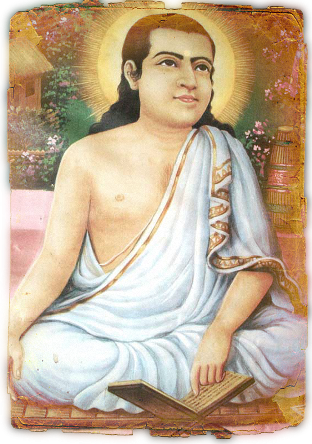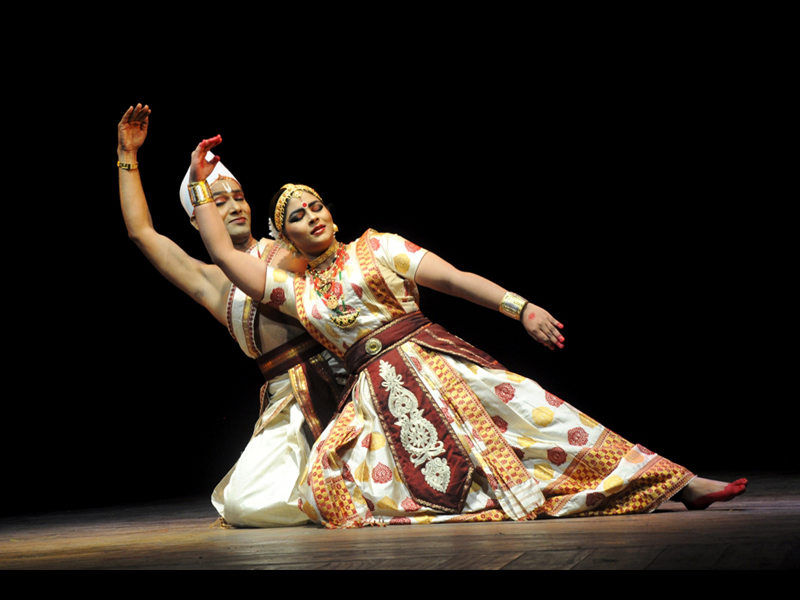The great Vaishnavite saint and reformer Srimanta Sankardev was born in Alipukhuri, Nagaon in 1449. His father was Kusumbar Bhuyan and his mother’s name was Satyasandhya.Mahapurush Srimanta Sankardev was a saint, scholar, playwright, social and religious reformer is a colossal figure in the cultural and religious history of Assam. He was destined to play a significant role in preaching to humanity and protecting human religion. ‘Ek Sarania Nam Dharma’ preached by him believed in worship of Lord Vishnu. Mahapurush Srimanta Sankardev was a great scholar and literacy genius.
His major literacy creations are the ‘Kirtan Ghosa’, ‘Gunamala’ etc. The holy songs written by him are known as ‘Borgeet’. The dramas written by him are known as ‘Ankia Naat’ and Sattriya Dance at that time was a part of it. In the ‘Ankiya Naats’ Srimanta Sankardev used the style of story telling through drama, mostly depicting the life of Lord Krishna and Lord Rama. The first dramatical work by him was ‘Chihnajatra’. The various ‘Ankia Naats’ written by him are ‘Kaliya Daman’, ‘Patni Prasad’, ‘Keli Gopal’, ‘Rukmini Haran’, ‘Parijat Haran’ and ‘Rambijay’ naat. When he started going to school at the age of twelve, he wrote a poem on the praise of Lord Vishnu -‘Karatala Kamala Kamala Dala Nayana’ without using any vowels as he had learnt only the consonants till that time.

The ‘Sattras’ or the monasteries set by the Vaishnavite saint developed as the hub of religious, spiritual and cultural life of the people of Assam. Srimanta Sankardev used the charm of art and culture to spread his philosophy of monotheism i.e. Vaishnavism, so that it could be used as a medium of instructions. The chief disciple of Srimanta Sankardev was Sri Sri Madhavdev, who also worked for spreading Vaishnavism and contributed by his literacy works including ‘Nam Ghosa’, ‘Bhakti Rattna’ etc.
The great saint died at the age of 120 years in 1568 in Koch Bihar.
Glimpses of his literary works :
Karatala Kamala Kamaladala Nayana (as in wikipedia)
In Assamese script
কৰতল কমল কমল দল নয়ন।
ভব দব দহন গহন-বন শয়ন ॥
নপৰ নপৰ পৰ সতৰত গময়।
সভয় মভয় ভয় মমহৰ সততয়॥
খৰতৰ বৰ শৰ হত দশ বদন।
খগচৰ নগধৰ ফনধৰ শয়ন॥
জগদঘ মপহৰ ভৱ ভয় তৰণ।
পৰ পদ লয় কৰ কমলজ নয়ন॥[1][4]
In Latin script
Karatala kamala kamaladala nayana |
Bhavadava dahana gahana vana sayana ||
Napara napara para satarata gamaya |
Sabhaya mabhaya bhaya mamahara satataya ||
Kharatara varasara hatadasa vadana |
Khagachara nagadhara fanadhara sayana ||
Jagadagha mapahara bhavabhaya tarana |
Parapada layakara kamalaja nayana ||[4]
English translation
Thy palm is like the lotus. Thine eyes are like the lotus petals.
Thou art the consumer of worldly afflictions. Thou art the sleeper in deep forest.
Thou art omnipresent and inner soul of all.
Thou constantly removest my fear and vouchsafest my safety.
Thou art the wielder of large swift arrows. Thou art the destroyer of the ten-headed demon.
Thou art the rider of the bird (Garuda) and the uplifter of the mountain. Thou art the reposer on the hooded serpent (Ananta).
Thou art the dispeller of worldly sins. Thou art the saviour from earthly grief.
Thou art the giver of final beatitude. O lotus-eyed Lord (I pray thee)

Depicting the ‘Fanadhara Sayana’.Thou art the reposer on the hooded serpent (Ananta).

Comments are closed.